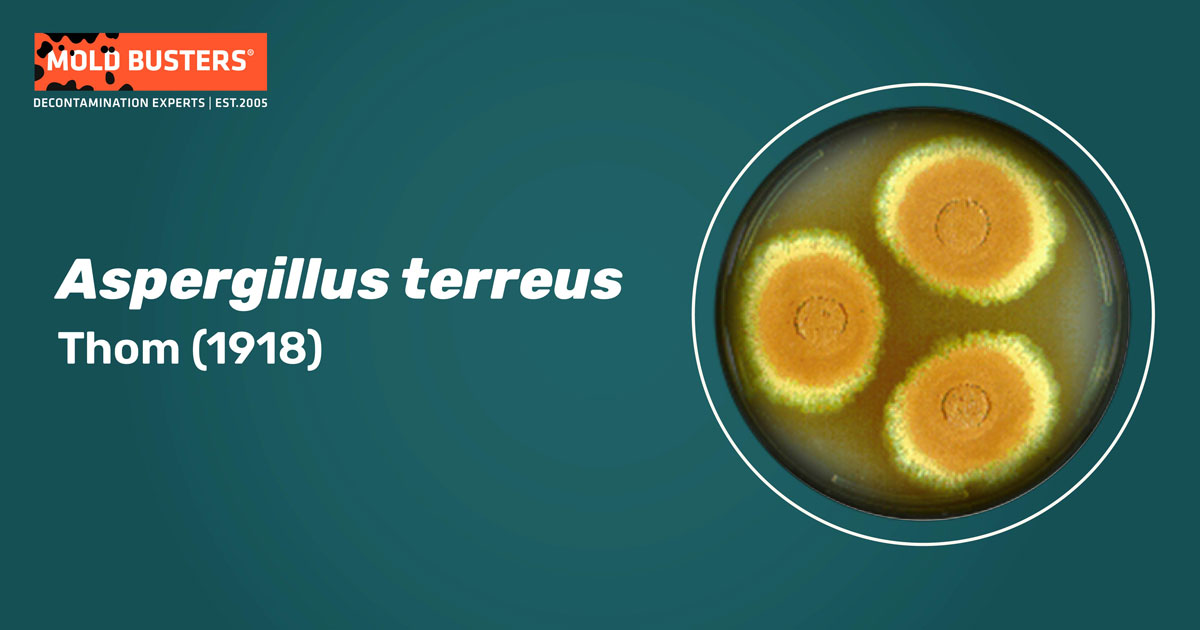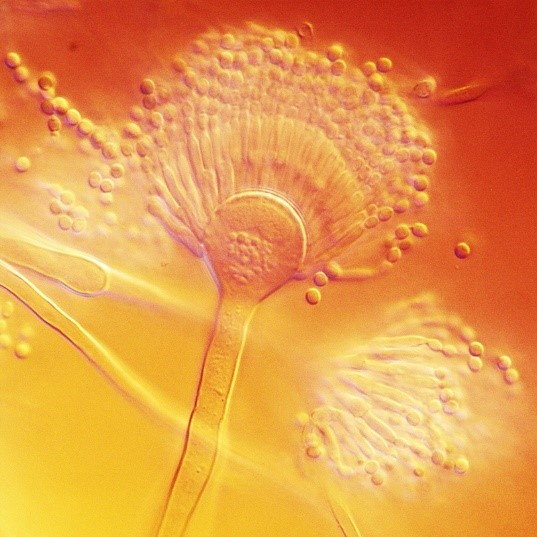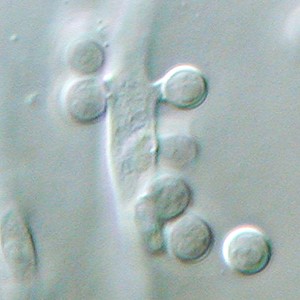Thom (1918)
What is Aspergillus tereus?
Aspergillus terreus is a filamentous fungus belonging to the Aspergillus section Terrei [1]. A. terreus is distributed worldwide and is commonly found in various natural habitats such as soil, grasslands, desserts, and compost heaps and stored grains [1,2,3]. A. terreus can also be pathogenic, causing opportunistic infections in humans [1, 2] and plants such as whey, rye, and potato [3].

Aspergillus terreus is well-known for producing economically significant compounds such as lovastatin (the drug that decreases blood cholesterol) and cyclosporine A (an immunosuppressive drug) [1]. It is also reported that this fungus synthesizes metabolites considered mycotoxins such as citreoviridin, patulin, citrinin, emodin, terretonin, geodin, territrems, gliotoxin, and cytochalasin E [1].
How does Aspergillus terreus look like?
When grown on Saubouraud Agar at 37 °C (98.6 °F) for 48 hours, A. terreus colonies are cinnamon-brown or white when grown on Potato Dextrose Agar [1, 3]. On Czapek agar, A. terreus grows rapidly, forming colonies that can be richly sporulating or fluffy, poorly sporulated [4]. A. terreus hyphae are segmented and branched [1,3]. Conidiophores (spore-bearing structures) are long, colorless, with conidia arranged in two rows (biserate) (Fig. 1) [4]. Conidia are 1.5-2.3 μm in diameter, globose to elliptical with smooth walls [4]. A. terreus also produces accessory conidia known as aleuriconidia or aleurospores [1, 3, 4]. These additional conidia are globose; glass-like cells formed laterally on the hyphae [4].

How to identify Aspergillus terreus?
A. terreus is the only member of the genus Aspergillus that produces accessory conidia. They can be produced singly or in groups (clusters) in submerged hyphae in culture media but also have been detected in host tissue during infection (Fig. 2) [4]. Therefore, identifying accessory conidia in specimens of infected patients implies that the infecting agent is A. terreus [4]. This aids in distinguishing this organism from Fusarium, Acremonium, and Paecilomyces, particularly from other Aspergillus species [4]. It is demonstrated that some strains of A. terreus produce accessory conidia abundantly, while other strains produce a very small number of these structures [4]. Some authors suggest that accessory conidia of A. terreus might play a role in the dissemination of disease. However, a correlation between the ability of the fungus to produce accessory conidia and the disease invasives has not been established yet [4].

Based on morphological characteristics, A. terreus is considered the only known species within the section Terrei, along with the varieties A. terreus var. aureus and A. terreus var. africanus. The latter two species are rarely encountered [4]. Both varieties are morphologically different from A. terreus, and they both form bright orange colonies on growing media [4]. Also, studies of evolutionary development revealed that apart from A. terreus, numerous morphologically indistinguishable species might be present within the sections Terrei [4, 5].
Since the species identification based on morphology is unreliable, more precise tools for identifying Aspergillus species at the molecular level is comparative genomic analysis (comparative DNA sequencing) [5]. Studies have shown that sequences coding structural and messenger cell proteins (such as β-tubulin and calmodulin) are excellent markers for species determination within the section Terrei [5].
Genome of Aspergillus terreus
The genome (the entire genetic information of an organism) of A. terreus has a total length of 28-32 Mbp [6, 7] (Mbp = Mega base pairs = 1,000,000 bp = fundamental unit of DNA) and 10,401 protein-coding genes [7]. The most studied part of the A. terrei genome is probably the gene cluster (group of two or more genes that encode similar proteins) responsible for the biosynthesis of lovastatin [8].
What are causes of Aspergillus terreus?
The most common infection caused by filamentous fungi among immunocompromised patients is invasive aspergillosis, and about 15% of such cases are due to Aspergillus terreus [2]. In highly immunocompromised hosts, A. terreus causes infections ranging from superficial infections to allergic bronchopulmonary aspergillosis, aspergilloma (a fungus ball composed of Aspergillus hyphae with cellular debris and mucus), and invasive diseases [1]. Compared to other Aspergillus species, A. terreus infections have been linked to dissemination and higher mortality [1]. Most affected individuals are the patients suffering from low blood cell count, transplants, inherited or acquired immunodeficiencies, and patients using corticosteroid drugs [1]. However, A. terreus also affects non-immunocompromised patients with underlying lung disease [1]. According to the reports, A. terreus is involved in many diseases such as blood malignancies, tumors, heart, kidney, and liver diseases [1].
Nail infection caused by Aspergillus terreus
A fungal infection of the nail plate and surrounding tissues is called onychomycosis and represents about 40-60% of nail diseases, making it a growing public health problem [9]. This condition affects mostly people older than 60 years and immunocompromised patients, patients with diabetes, and patients with blood circulation disorders [9]. It can be caused by dermatophytes (fungi that require keratin for growth, such as ringworm), yeast (such as Candida albicans), and non-dermatophyte molds like Aspergillus species, Fusarium species, Acremonium species, and Scytalidium species [9]. Acting like contaminants, colonizers, or pathogens, non-dermatophytes can infect people using public swimming pools and bathrooms or manicures [9]. Toenails are infected twenty-five times more frequently than fingernails by Aspergillus sp. [10], and A. terreus is reported to affect the toenails of the first toes [9].
Nail infection caused by Aspergillus spp. begins under the nail where spores may get stuck, at the lateral nail folds, or on a diseased nail plate colonized by fungus [10]. Starting to grow, the fungus causes the infection to spread back toward the cuticle (skin along the bottom edge of a finger or a toe) [10]. It causes nail discoloration, thickening, distortion, and flakiness. Nails can become chalky and painful without pus [10]. A nail infection caused by Aspergillus species may disseminate in immunosuppressed patients, becoming the door to systemic, more threatening infections [10].
How to treat Aspergillus terreus?
Due to resistance to amphotericin B, preferred agents for treating invasive aspergillosis caused by A. terreus in most patients are triazoles (such as vorriconazole and isavuconazole) [1]. Prevention and early antifungal treatment are important and immunomodulation, but in some cases, surgery is necessary [1]. Strategies for treating invasive A. terreus infection need to be based on an epidemiology assessment and individual risk factors [1]. When it comes to treating infected nails, it is important to note that inadequate therapy may cause resistance and recurrence of infection.
The duration of treatment depends on which nails are affected and the severity of the infection. Infected fingernails typically require three months of treatment, while healing of toenails lasts six months or longer [10].

Did you know?
Stachybotrys is the 2nd common toxic mold type found in homes we tested?! Find out more exciting mold stats and facts on our mold statistics page.
References
- Lass-Flörl. C. (2018). Treatment of Infections Due to Aspergillus terreus Species Complex. Journal of Fungi. 4 (83): 2-9
- Lass-Flörl. C. (2012). Aspergillus terreus: How Inoculum Size and Host Characteristics Affect Its Virulence. The Journal of Infectious Diseases. 205 (8): 1192-1194
- Louis, B. et al. (2013). Aspergillus terreus Thom a new pathogen that causes foliar blight of potato. Plant Pathology & Quarantine. 3 (1) :29–33.
- Balajee, S. (2009). Aspergillus terreus complex. Medical Mycology. 47 (Supplement 1), S42-S46
- Balajee, S. A. et al. (2007): Aspergillus species identification in the clinical setting. Studies in Mycology 59: 39-4
- The National Center for Biotechnology Information. Retreated from: ncbi.nlm.nih.gov
- The National Center for Biotechnology Information. Retreated from: ncbi.nlm.nih.gov
- Savitha, J. et al. (2016). Complete Genome Sequence of Soil Fungus Aspergillus terreus (KM017963), a Potent Lovastatin Producer. Genome Announcements. 4(3): e00491-16
- Fernández, M. S. et al. (2013). Aspergillus terreus complex: an emergent opportunistic agent of Onychomycosis. Mycoses. 56(4): 477-81
- Bongomin, F. et al. (2018). A Review of Onychomycosis Due to Aspergillus Mycopathologia. 183: 485-493

Get Special Gift: Industry-Standard Mold Removal Guidelines
Download the industry-standard guidelines that Mold Busters use in their own mold removal services, including news, tips and special offers:

Written by:
Jelena Somborski
Mycologist
Mold Busters
Edited by:
Dusan Sadikovic
Mycologist – MSc, PhD
Mold Busters
